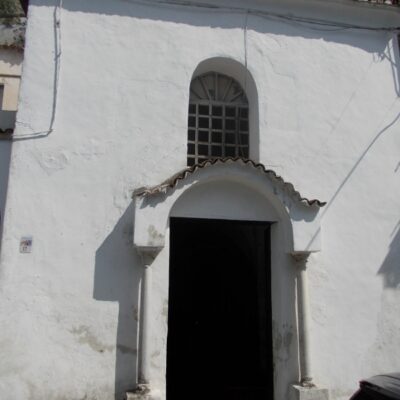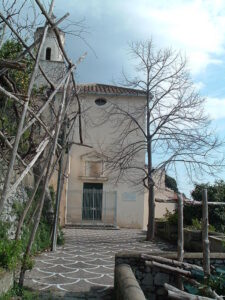MUNICIPALITY: Ravello
NAME: Church of St. Angelo dell’Ospedale
LOCATION: Viale della Rimembranza
DESCRIPTION: The church, attached to an ancient structure used as a resting place for pilgrims that has now completely disappeared, is located halfway between the historic center of the town and Piazza Fontana Moresca. It appears in a document from 1039 and occupies a natural cavity about 30,00 meters long connected to another similar one by a U-shaped tunnel and parallel to it. The structure has a factory facade on the road, with a gabled profile framed by two columns, and is divided into two rectangular rooms by an altar.
The innermost room, certainly the first place of worship, ends with an apse, and the walls are welded to the rock in a very harmonious manner. The altar of the outermost room appears in its most recent phase, when it underwent restoration at the end of the 19th century and was embellished with a fresco of the Madonna and the Divine Infant, while the geometric decoration of the side walls reveals hints of the 14th century. Already in the 1100s, there must have been a phase of enlargement aimed at making the rooms conform to the five-apse model, which here realizes only three, due to lack of space.
It is interesting to note the small pulpit from the 13th century, resting on columns, one of which has a white marble capital of exquisite workmanship, and a series of apsidal compartments accessible from the sacristy, to the right of the altar.
The whole complex, equipped with a still-used cistern placed under the floor of the outermost room (to which water flowed from a collection tank located in one of the innermost compartments), includes numerous columns, very small but characterized by capitals showing decoration of the European influence.
The small chapel has a four-story bell tower next to it. The floors are not always interconnected because in some places they lean directly on the rock.
The building phases of the structure clearly show that this cavity must have been used at first as a place of cave worship and only later, at a time coinciding with his expansion, it was transformed into a cenoby and resting place for pilgrims (the nearby Hospital).
SEE, VISIT, FIND: The church is mostly open; however, to visit it one must arrange a time and date with the custodial staff of the cathedral by contacting the pastor.
FRUITION DATA: None
OPPORTUNITIES: The lack of historical-artistic information on site makes it difficult to enjoy this very important asset. At the very least, information panels would be needed. Lesser-known monumental properties can also be enhanced and gain more visibility if they are included in guided tour routes or presented through information materials. In this case, the itinerary could be about religious architecture in Ravello or places of worship in caves traceable to the monastic currents present throughout the Amalfi Coast.
BIBLIOGRAPHY: FULCHIGNONI G., Ravello. Le cento chiese, Amalfi 2001
IMPERATO G., Ravello nella storia civile e religiosa, Cava d. T. 1990.
CAFFARO A., Insediamenti rupestri del Ducato di Amalfi, Salerno 1986.
MANSI L., Ravello sacra-monumentale, Ravello 1887




